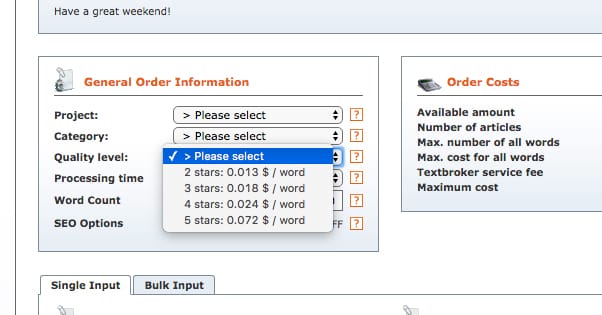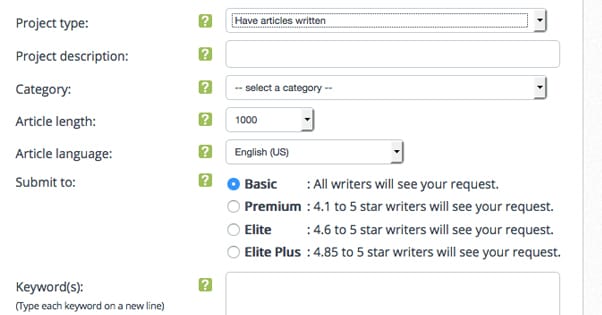A Comparison of Contently vs Textbroker vs iWriter
Published by James Parsons • Content Marketing • Posted May 28, 2016 ContentPowered.com
ContentPowered.com
The life of a blogger is one filled with work. Imagine if you’re posting one blog post per day, five days per week. That’s 260 blog posts. Each post is, say, 2,500 words. That’s 650,000 words of writing. If it takes you an hour to write 1,000 words, that’s 27 solid days worth of writing throughout the year. That doesn’t even consider time spent gathering data and reading research, let alone generating ideas for it all in the first place.
Do you really want to spend a full month of your life writing posts for your blog?
One of the solutions to this problem is to hire a bunch of writers. The problem with that, is that they tend to require quite a bit of guidance, overview, and money. You need to train them, you need to manage them, and you need to cope with them coming and going, since they’re almost undoubtedly freelancers with multiple clients and life events requiring their attention. Sure, a dry spell is easier to handle than doing it all yourself, but it’s still a hassle if your time is valuable.
The real solution here, and the solution thousands of bloggers use on a weekly basis, is paying for writing. You can hire ghostwriters through so-called “content mills” to get you content per your specifications, with full unique rights to that content, for a lot lower of a price than you get from hiring writers directly.
There are a lot of ways to get content out there, but the three I’m going to talk about today are the three listed in the title. We’re talking about Contently, iWriter, and Textbroker.
Textbroker
Starting off with Textbroker here makes sense because, of the three, it is the least complex to describe. It’s a fairly simple platform. You sign up as a client and are given access to various tools that allow you to post assignments. Your assignments are quite open-ended; you essentially have a text box to submit your idea. You can choose to have certain keywords required and certain densities for those keywords, and you can choose a specific word range.
There are three ways you can submit an order. You can submit on the open pool, you can form a team, or you can submit directly to a specific writer. In the open pool, you have star levels to pick from, ranging from 2 star to 5 star. The lower the star level, the lower the quality of the writing, and the lower the price. Level 2 is 1.3 cents per word, level 3 is 1.8, level 4 is 2.4, and level 5 is 7.2. The reason there’s such a high jump to level 5 is that level 5 writers are the closest things to professionals you can get on Textbroker. They have to take a test to reach rank 5, and they tend to be much better in quality. Of course, a 1,000-word article at 7.2 cents per word is $72 for a post, and that can grow very expensive very quickly. This is why most clients opt for 4-star content.
Teams can be open auditions or hand picked from writers you want to invite. You can set your own price, with 2.4 cents minimum per word. Direct orders, of course, are specific assignments to specific writers. The writer sets their price, so you have to be willing to pay what the writer wants to ask.
Now, having used Textbroker myself, I can tell you one thing for sure; the content is not great. I didn’t experiment much with 5-star due to the price, but at the 4-star level you’re going to have a lot of mediocre content on your hands. I’ve heard that a lot of client layer in thousands of words of guidelines to try to make the content viable, and even then they often get garbage. There are some very good writers toiling away at the 4-star level, but you have no control over whether or not they pick up your assignments. You have to luck into finding them before you can send them direct orders.
Textbroker also has a managed service where their account reps will edit content and guarantee a higher level of quality, something around 4.5 star or 5 star. However, this requires that you start with a budget of $2500, which is insurmountably high for most bloggers looking to buy cheap content.
If you don’t like the content you receive you are allotted one free revision, which the writer is free to do or to drop the order. If they choose to drop the order, you have to start over with the order in the open pool or team pool as the case may be. You can’t reject a post until after that first revision. You’re free to request more revisions as long as the writer is willing to do them, but many writers will drop articles on revisions for fear of being rejected, which dramatically hurts their standing on the site. You don’t pay extra for revisions, however, you do have a time limit. If you don’t cancel, reject, or submit a revision on a submission within 72 hours, you automatically accept the content and pay the writer.
All things considered, I do not recommend Textbroker. The quality of the content is simply too low in general. If you happen to find a good writer, you can get some great content for a much lower price than you might expect, but that’s a rarity. The price is low, but you’re getting what you pay for. You’re also very limited in the revisions you can request.
iWriter
iWriter is the first on our slate. One thing to mention right off the bat is that despite the lower case i prefix, they are not associated with Apple or their iDevices product lines. It’s just a branding style that they adopted.
This platform and Textbroker work very much the same. You post content to a pool and writers can pick it up to write it, at varying star levels and varying prices. Their pricing is a lot more complex, though. They also have four star levels, 1-4, labeled Standard, Premium, Elite, and Elite Plus. However, their services also depend on the kind of content you want to get.
For example, the basic blog article at standard level runs $7.50 for 1,000 words. At the 4-star level that same 1,000 words costs you $64.75. The scale isn’t perfectly per-word, however. 500 words at the 4-star level will cost you $35. You get discounts for larger orders, essentially.
Other types of content have restrictions. You can order article rewrites, like if you want to cover a topic from an existing blog post but need unique content – like manual spinning – or have a first draft you need polished into something good. The prices are the same for this, but you cannot order them at the 1-star level, so the minimum possible price is higher. There are also bulk prices for ebooks and kindle books that start at $160 for 7,000 words at the 2-star level.
As for the quality of the content, again, you’re probably going to get what you pay for. iWriter and Textbroker actually share a lot of the same writers, because writers at such low pay levels need to work in bulk if they want to make any significant amount of money. This means they put the bare minimum amount of effort into the projects they do, and they don’t care much for time consuming details. iWriter has a problem with rating scamming, however, so writers ranked 3-star might not actually have earned their way to that point.
The best content you can get out of iWriter would be mediocre blog content, serviceable but not great, and you’re going to have to take their top level to get it. This means you’re going to be paying a pretty penny. It’s only a few dollars cheaper than the top tier of Textbroker work.
Contently
Contently is not a content mill the same as the other two. In actuality, they are a CRM software company that manages your blog for you, among other social media services and marketing services. They’re designed for high tier clients, and clients like Consumer’s Digest, Buzzfeed, Esquire, and Investopedia all use it for content.
Contently does a lot more than just text, which puts them leagues ahead of the other two on this list. They have photographers, videographers, writers, journalists, graphic artists, and a lot more. The idea is that you can get a complete blog from their service, not just text. Images, videos, and anything else you need to market your brand can come from Contently.
Unfortunately, I can’t give you an idea of the price of their services, because they vary depending on your needs and the deal you strike with their sales team. I will say this; they are leagues above the content mills. Some companies pay $200-$300 per blog post. Some pay $600 or more. Some pay as much as $2 per word, making a 1,000 word article very, very pricey. You can see some information on client pricing here.
On the other hand, you’re getting a lot more than just writing out of Contently. You’re getting, at the bare minimum, professional level writing and graphics to go along with it. You can also get research, infographics, and videos if that’s what your contract allows. It can get very expensive, but the quality of the content you receive is worth it. Unless, of course, you’re a small business that doesn’t have the budget to spend thousands of dollars a month on content.
There are a lot of issues with using companies like Textbroker and iWriter for your blog. They’re cheap, yes, and they save you time, but they’re not producing high quality content. If you’re going for anything lower than the top tier, or a personally vetted team on Textbroker, you’re likely getting content from ESL speakers who don’t actually know the standards of grammar on the web. Writers are prone to dropping troublesome clients, which can leave you in a lurch.
The number one tip I’d give is to be picky. The number two tip is to plan out at least six months in advance. It can sometimes take weeks to get a high quality post out of an assignment, and you don’t want to be stuck with nothing to post.
Always try to work with the highest tier writer you can afford. For Textbroker, I recommend setting up a team with an entry requirement assignment – you can’t use these on your blog but they give you an idea of the quality of the writer – and a pay level that is somewhere between 4 and 5 star. Somewhere around 4-5 cents per word should do. This will drive away the worst of the writers who aren’t confident in themselves, but it will be high enough to attract the upper tier writers who are looking for more than the base rates.
Be picky with the content you receive. As long as you have a large enough content buffer, you can afford to revise and revise until you get something satisfactory. It’s only when you’re pressed for time that you start accepting poor content just to have something to post.
As for your assignments, don’t worry about specified keywords and try to keep your topics relatively narrow. Don’t go too narrow or you will drive away writers who don’t want to put in the work learning about the topic. On the other hand, don’t go too broad, or you’ll get 15 variations on the Beginner’s Guide to Topics. Don’t do what some clients do and make a 15-page external Google Doc with additional guidelines; no writer will pay attention to those.
My best tip, though, is simply to get above and beyond this cheap level of writing as fast as possible. The better your content, the more you will attract visitors and links, and the more your site will grow. When you can afford to pay more, you can attract better writers and better customers, and you can grow to a level where you can have Contently or another management company handle your blog for you. It’s worth the climb.











Exactly what I needed to know, thanks James! Contently seems a bit out of my budget so it seems Textbroker 4-5 star articles are my best option until I can afford better.